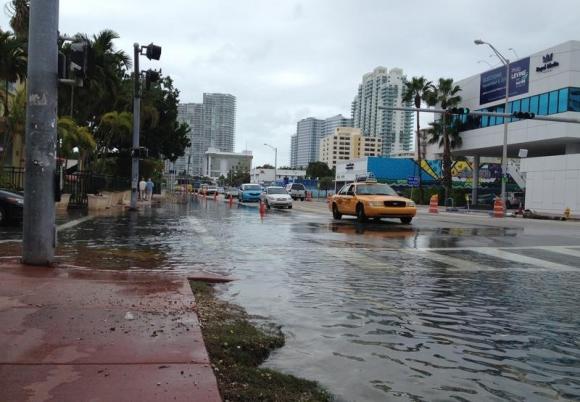U.S. coastal flooding on the rise, government study finds
Date: 29-Jul-14
Country: USA
Author: Ryan McNeill

Flooding at Alton Road and 10th Street is seen in Miami Beach,
Florida on November 5, 2013.
Photo: Zachary Fagenson
Flooding is increasing in frequency along much of the U.S. coast, and the rate of increase is accelerating along the Gulf of Mexico and Atlantic coasts, a team of federal government scientists found in a study released Monday.
The study examined how often 45 tide gauges along the country's shore exceeded National Weather Service flood thresholds across several decades. The researchers found that the frequency of flooding increased at 41 locations. Moreover, they found that the rate of increase was accelerating at 28 of those locations. The highest rates of increase were concentrated along the mid-Atlantic coast.
"We stress that in many areas, the frequency of nuisance flooding
is already on an accelerating trajectory, and many other locations
will soon follow" if trends in rising sea levels continue, the
scientists wrote.
The thresholds are usually associated with minor flooding, also
called nuisance flooding, which can overwhelm drainage systems,
cause road closures and damage infrastructure not built to withstand
frequent flooding or exposure to salt water. Such flooding is one of
the more recognizable effects of rising seas, as opposed to less
frequent but more damaging extreme storms, such as hurricanes, the
scientists said.
In the 1950s, nuisance flooding occurred once every one to five years, the study found. By 2012, the frequency had increased to about once every three months at most NOAA gauges.
These storms "are no longer really extreme," said William Sweet, a NOAA oceanographer and lead author of the study. "It takes a lesser storm to inundate similar (elevations)."
The study is the latest to examine whether minor flooding is increasing as seas rise. Reuters published the results of its own independent analysis earlier this month that found that the number of days a year that tidal waters reached or exceeded flood thresholds more than tripled in many places.
Another study, by Old Dominion University researchers Tal Ezer and Larry Atkinson, found that the U.S. East Coast is "a hotspot of accelerated flooding." They also found that flooding outside of storm events has increased in frequency and duration. The results of their study are expected to be published later this year.
Among the NOAA study's findings:
*The northeast Atlantic coast experienced a "significant increase" in nuisance flooding, largely because of the combination of rising sea levels and subsidence, whereby land sinks due to geological forces and the extraction of groundwater.
*In the southeast Atlantic, five of eight gauges "are now on an accelerating nuisance flood frequency trajectory."
*Four of the eight gauges on the Gulf coast showed accelerating increases in minor flooding.
Such flooding events "are only going to become more noticeable and much more severe in the coming decades" as the seas continue to rise, Sweet said.
The scientists warned in their report that coastal communities may face a "time horizon" when public and private infrastructure "will become increasingly compromised by tidal flooding." That time is dependent on how fast seas rise --- something scientists can't predict.
"When that day comes, these impacts are going to be accelerated," Sweet said, "and that's going to spell all sorts of issues for communities when it comes to adaptation and resilience."
(Edited by John Blanton)
![]()
© Thomson Reuters 2014 All rights reserved